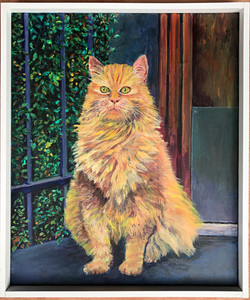
Karel Appel
Little Boy, 1969
Color lithograph on wove paper
Hand signed and numbered 8/200 by the artist on the lower front
30 × 22 1/2 inches
About Karel Appel:
Karel Appel was born on April 25, 1921, in Amsterdam. From 1940 to 1943 he studied at the Rijksakademie van Beeldende Kunsten, Amsterdam. In 1946 his first solo show was held at Het Beerenhuis, Groningen, Netherlands, and he participated in Jonge Schilders (Young painters) at the Stedelijk Museum, Amsterdam. About this time, Appel was influenced first by Pablo Picasso and Henri Matisse, then by Jean Dubuffet. He was a member of the Nederlandse Experimentele Groep (Dutch Experimental Group, 1948) and established the Cobra group (1948–51) with Constant (Constant Nieuwenhuys), Corneille (Guillaume Cornelis Beverloo), and other painters from Copenhagen, Brussels, and Amsterdam. The style distinguished itself through bold, expressive compositions inspired by folk and children's art, as well as by the work of Paul Klee and Joan Miró. In 1949 Appel completed a fresco for the cafeteria of the city hall in Amsterdam, which created such controversy that it was covered for ten years.
In 1950 the artist moved to Paris; there the writer Hugo Claus introduced him to art critic Michel Tapié, who organized various exhibitions of his work. Appel was given a solo show at the Palais des beaux-arts, Brussels, in 1953. He received the UNESCO Prize at the 1954 Venice Biennale and was commissioned to execute a mural for the restaurant of the Stedelijk Museum in 1956. The following year Appel traveled to Mexico and the United States and won a graphics prize at the Ljubljana Biennial in Yugoslavia. The first major monograph on Appel, written by Claus, was published in 1962. In the late 1960s, the artist moved to the Château de Molesmes, near Auxerre, southeast of Paris. Solo exhibitions of his work were held at the Centre national d'art contemporain, Paris, and the Stedelijk Museum (1968), and at the Kunsthalle Basel and the Palais des beaux-arts (1969). During the 1950s and 1960s he executed numerous murals for public buildings. A major Appel show opened at the Centraal Museum, Utrecht, Netherlands (1970), and a retrospective toured Canada and the United States (1972).
In the 1970s and 1980s, Appel continued to work simultaneously in sculpture and painting, pushing his abstraction further with his window paintings—a series he began in 1980. Appel also gradually introduced landscape into his iconography, which would develop into a more consistent engagement in the last decade of his work. In the 1980s, Appel also began his collaborations with American poet Allen Ginsberg, which would continue over the next ten years. In his later career, his work was the subject of numerous solo exhibitions organized by Museum Boijmans Van Beuningen, Rotterdam (1982); Castello di Rivoli–Museo d'arte contemporanea, Turin, Italy (1987); National Museum of Art, Osaka (1989); Stedelijk Museum (1998, 2000, and 2001); and Cobra Museum voor Moderne Kunst, Amstelveen, Netherlands (2001). Appel died on May 3, 2006, in Zurich.
courtesy to the Guggenheim









